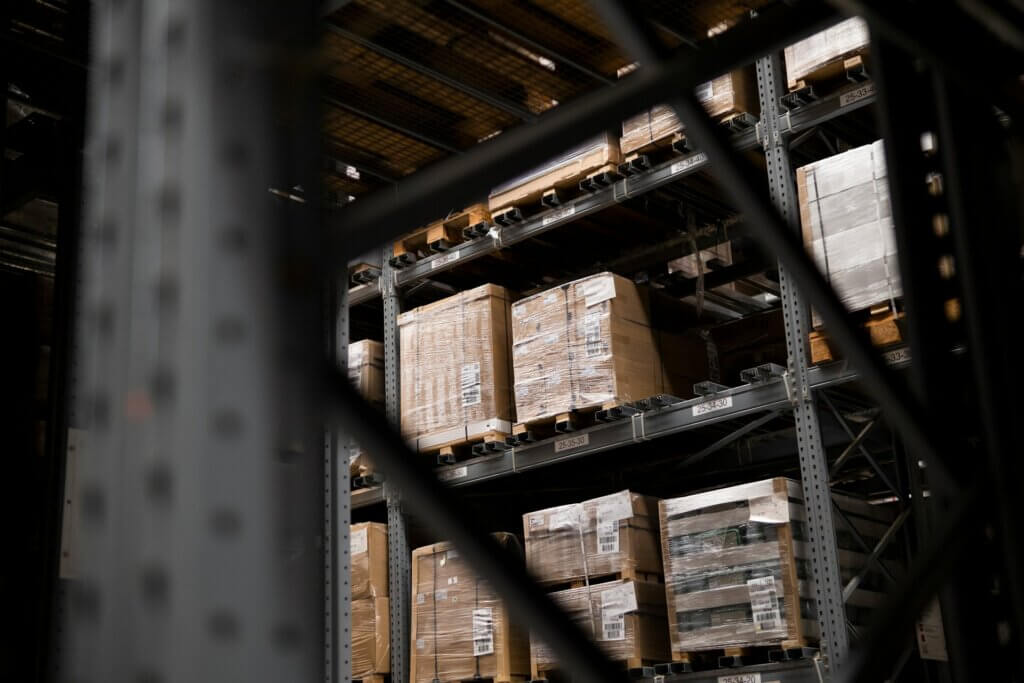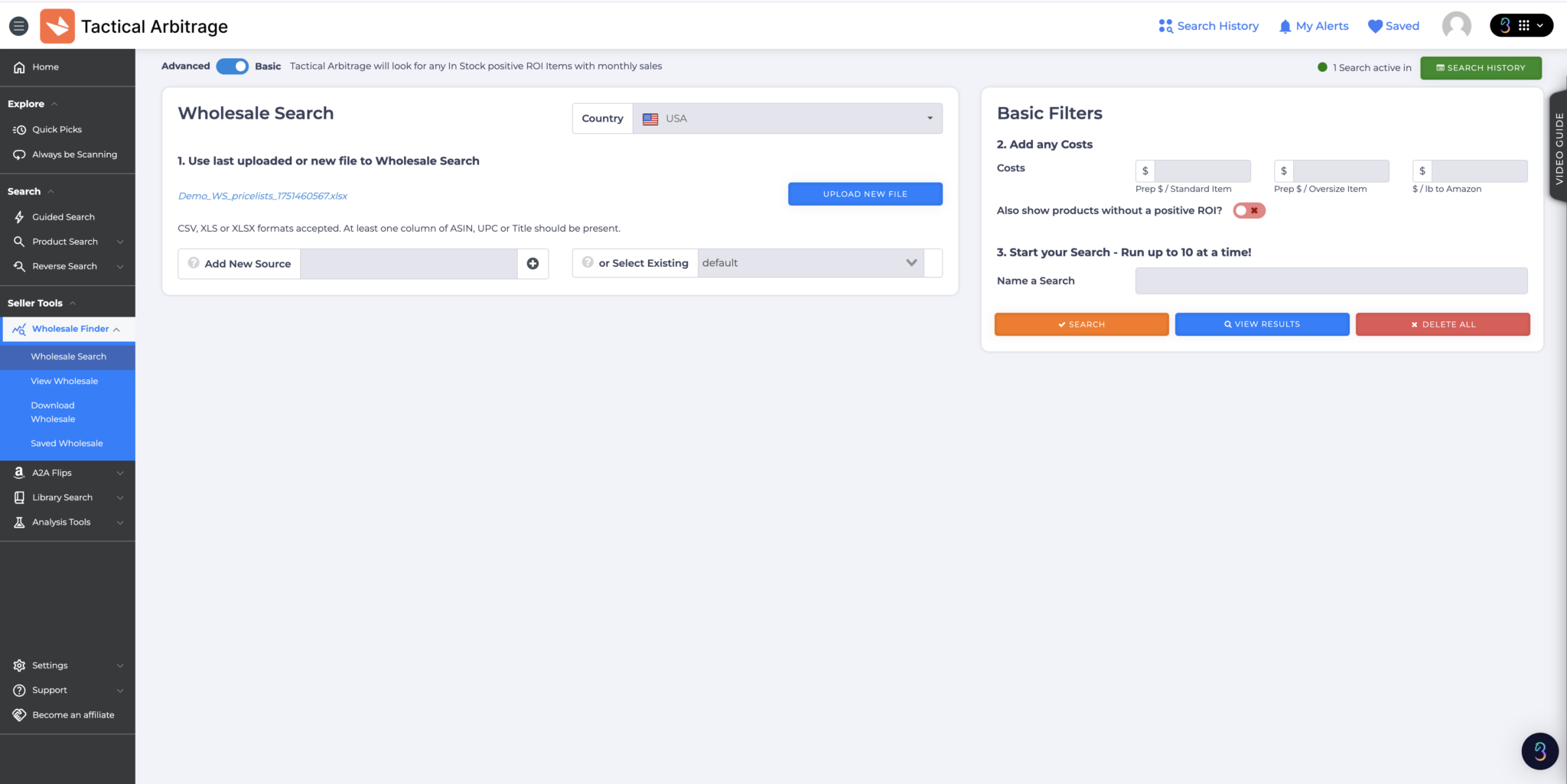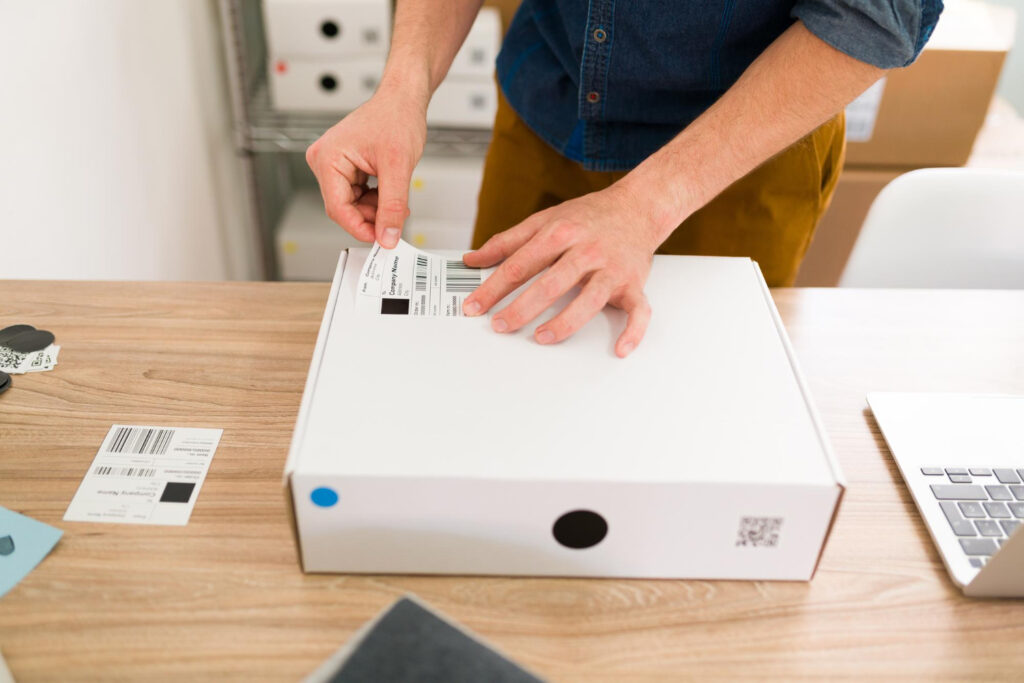- Blog
-
For Sellers
How to find Amazon FBA wholesale suppliers in 2025
Wholesale sounds simple… until you’re knee-deep in dead leads and reseller red tape. Here’s how to find real suppliers without wasting weeks.

Searching for wholesale suppliers can feel like detective work. You’re scrolling through directories, sending cold emails, and wondering if that supplier in your inbox is legitimate or just another middleman ready to waste your time and money.
The wholesale model offers something other Amazon selling strategies can’t match: established brands people already want to buy. You skip the years of brand building required for private label. You avoid the unpredictable inventory of retail arbitrage. Instead, you’re selling products with proven demand and steady sales history.
But finding the right suppliers takes strategy, and knowing where to look makes the difference between building a sustainable business and burning through capital on bad deals.
Why purchase products at wholesale to resell on Amazon
Wholesale selling puts you in business with brands that already have customer trust. When someone searches for a KitchenAid mixer or a Dyson vacuum, they’re looking for those specific brands. You’re tapping into existing demand instead of trying to create it from scratch.
Bulk buying delivers better margins. A product that costs $40 retail might cost you $20 when you’re ordering 50 units at once. Those savings compound with every order, and as your relationship with suppliers grows, you can negotiate even better terms.
Here’s what makes wholesale attractive:
- Established brands with proven demand — No need to build brand awareness from zero
- Better profit margins from bulk pricing — Lower per-unit costs that improve with volume
- Faster startup than private label — Products and listings already exist
- Predictable supply chains — Reorder confidently from reliable sources
- Sustainable scaling potential — Automate operations as you grow
Speed matters when you’re building a business. Private label sellers spend months developing products, creating packaging, and building brand awareness before making their first sale. Wholesale sellers can have inventory listed and selling within weeks because the products and listings already exist.
Supply chains become predictable. Once you establish a relationship with reliable suppliers, you can reorder confidently, maintain consistent stock levels, and avoid the feast-or-famine cycles that plague other selling models. This stability lets you forecast revenue and plan growth.
Understanding the wholesale model
Wholesale differs fundamentally from other Amazon selling approaches. You’re buying branded products in bulk from manufacturers, distributors, or authorized wholesalers, then reselling them at retail prices on Amazon. The brands already exist, the listings are already live, and customers are already searching.
How wholesale compares to other models:
| Wholesale | Private Label | Retail Arbitrage |
| Sell existing brands | Create your own brand | Buy clearance deals |
| Higher upfront investment | Highest investment required | Lowest startup costs |
| Bulk ordering from suppliers | Manufacturing overseas | Store-by-store hunting |
| Predictable reordering | Long lead times | Inconsistent inventory |
Capital requirements run higher than other models. Expect to invest $2,000 to $5,000 for your initial inventory and fees, with minimum order quantities varying from $500 to several thousand dollars, depending on the supplier. Ongoing costs include product restocking, FBA storage fees, Amazon referral fees, and shipping.
Target margins typically land between 20-30% net profit after all costs. That might sound modest compared to the inflated margins promised by other models, but wholesale profits are sustainable and repeatable. You’re building a business on steady volume, not chasing one-off deals.
Required legal documentation:
- Business registration (LLC, corporation, or sole proprietorship)
- Sales tax permit or reseller certificate for tax-free purchasing
- Employer Identification Number (EIN) for tax purposes and account opening
- Business license, depending on your state requirements
- Additional brand-specific verification documents when requested
Some brands demand additional verification. They’ll want invoices, resale certificates, or proof of tax compliance before approving your account. Amazon has its own hoops: product restrictions and category gating requirements that you must clear before selling certain brands or categories.
Where to find wholesale suppliers for your Amazon business
Top supplier directories to explore:
- Wholesale Central — Broad directory covering multiple product categories
- SaleHoo — 8,000+ verified suppliers with market research tools
- ThomasNet — U.S. and Canadian industrial suppliers
- Worldwide Brands — 16 million+ products from established distributors
- TopTenWholesale — B2B directory with 4,000+ suppliers
These directories do the initial vetting work for you. They verify supplier legitimacy, confirm active distribution, and organize suppliers by category. You’re still responsible for final verification, but you’re starting from a pool of legitimate businesses instead of sorting through search engine results.
Trade shows put you face-to-face with decision makers. Events like ASD Market Week gather wholesalers and distributors in one location, letting you evaluate products, negotiate terms, and build relationships in person. You can see product quality firsthand, compare multiple suppliers in a single day, and often negotiate better deals than you’d get through cold outreach.
Direct manufacturer contact works especially well with small to mid-sized brands. Large corporations have rigid authorization processes and exclusive distribution agreements. Smaller brands often welcome new retail partners and can offer better margins because you’re cutting out distributor markups.
Search for brands in your target category, visit their websites, and look for “Become a Retailer” or “Wholesale Inquiries” pages. If you don’t see one, reach out anyway. A professional email explaining your Amazon business and requesting wholesale terms can open doors that don’t appear on their website.
Effective Google search strategies:
- “wholesale distributor + [product category]”
- “[brand name] + authorized distributor”
- “[product type] + bulk supplier”
- “[industry] + wholesale suppliers USA”
Google searches uncover suppliers that don’t advertise widely. These search terms surface suppliers that rely on direct outreach rather than directory listings. Industry-specific distributors often operate this way, supplying multiple brands within their niche.
Distributor networks exist for most major product categories. These companies carry multiple brands, handle large volumes, and maintain relationships with manufacturers. They’re particularly common in toys, electronics, health and beauty, and sporting goods. Finding the right distributor can give you access to dozens of brands through a single relationship.
How to evaluate wholesale suppliers
Verification starts with basic business information. Confirm the supplier has a registered business, physical address, and working contact information. Check online reviews, Better Business Bureau listings, and third-party verification databases. Legitimate wholesalers operate transparently and have a documented history.
Supplier verification checklist:
✓ Confirm business registration and physical address
✓ Check BBB listings and online reviews
✓ Request recent invoices or product catalogs
✓ Ask for references from existing customers
✓ Verify active relationships with brands
✓ Review their return and warranty policies
✓ Confirm shipping timelines and minimum orders
Request recent invoices or product catalogs to verify active distribution. Actual wholesalers can easily provide these materials. They have current relationships with brands and can show you exactly what they carry. Middlemen and dropshippers struggle to produce documentation because they’re reselling from someone else.
Ask for references from existing customers. Established suppliers can connect you with other retailers who can speak to their reliability, product quality, and service. If a supplier refuses or claims all their customers are confidential, that’s a warning sign.
Red flags that should stop you immediately:
🚩 Inconsistent or slow communication
🚩 Vague answers about pricing or terms
🚩 Aggressive sales tactics or pressure
🚩 No verifiable business address
🚩 Missing certifications or documentation
🚩 Refusal to provide samples
🚩 Unclear return policies
🚩 Prices that seem too good to be true
Quality control prevents expensive mistakes. Request product samples before placing bulk orders. The cost of a few samples is trivial compared to the capital you’ll lose on a full order of substandard products. Inspect samples for quality issues, packaging damage, or anything that could generate customer complaints.
Third-party inspection services can assess large orders before shipment. For suppliers you’re testing for the first time or for significant orders, paying for professional inspection catches problems before products reach Amazon’s warehouses. Look for relevant certifications—ISO for manufacturing standards, FDA compliance for food and health products.
Trial orders prove reliability. Start with the minimum order quantity, even if you’re confident in the supplier. This tests their fulfillment speed, communication during fulfillment, product quality, and accuracy. A successful trial order builds confidence for larger commitments.
Analyzing profitability before you buy
Product analysis prevents expensive mistakes. Use Amazon’s Best Sellers Rank (BSR) to gauge demand—lower numbers indicate higher sales volume. Look for consistent sales patterns rather than products with erratic spikes. Avoid highly seasonal items unless you can manage the inventory fluctuations.
Competition levels tell you if there’s room for another seller. Listings dominated by Amazon itself rarely leave profit for third-party sellers. Products with just one or two sellers might indicate restricted categories or authorized seller requirements. Look for listings with multiple sellers but not so many that you’ll be trapped in constant price wars.
Product evaluation criteria:
| Factor | What to Look For | Red Flags |
| BSR | Consistent rank under 50,000 | Erratic spikes, ranks above 100,000 |
| Competition | 5-15 active sellers | Amazon-dominated or 30+ sellers |
| Price Stability | MAP policies in place | Constant price wars |
| Margins | 20-30% net profit | Under 15% after all fees |
| Category | Ungated or approved | Restricted without approval |
Check for Minimum Advertised Price (MAP) policies. Brands with MAP policies set a floor for pricing, which prevents destructive price competition. These products offer more stable margins because sellers can’t undercut each other below the MAP threshold.
Category gating determines if you can even sell certain products. Amazon restricts some categories and brands to approved sellers only. Check category requirements before investing in inventory. Getting ungated can take weeks or months, and some categories require invoices from specific approved suppliers.
To make catalog analysis faster, use Tactical Arbitrage’s Wholesale Search. Upload a supplier’s product list as a spreadsheet (CSV, XLS, or XLSX format with UPCs, prices, and titles), and the tool automatically analyzes each product’s profitability on Amazon. It checks current pricing, calculates fees, estimates profit margins, and flags products above your target ROI.

What Tactical Arbitrage’s Wholesale Search analyzes:
- Current Amazon pricing and Buy Box position
- All FBA fees and fulfillment costs
- Profit margins and ROI percentages
- Competition levels and seller count
- Sales rank and velocity trends
- Category restrictions and gating requirements
The tool surfaces opportunities you’d never find through manual analysis. It processes thousands of SKUs while you’re working on other parts of your business, identifying the 20-30 products worth buying from a catalog of hundreds. This speed lets you evaluate multiple suppliers in a single day instead of spending a week on just one.
Build sustainable supplier relationships
Professional communication establishes your credibility from first contact. Send clear, concise emails that introduce your business, explain what you’re looking for, and request specific information. Avoid vague inquiries—suppliers receive dozens of generic emails daily, and specific questions demonstrate you’re serious.
What to include in your initial supplier outreach:
- Your business name and type (LLC, corporation, etc.)
- Sales channels you operate (Amazon, website, retail)
- Target order volumes and frequency
- Product categories of interest
- Specific questions about MOQs, pricing, and terms
- Your reseller certificate and EIN availability
Provide required documents promptly. When a supplier requests your resale certificate, EIN, or business license, respond quickly with clean, current versions. Delays signal disorganization and may cause suppliers to prioritize other potential customers. Keep these documents readily accessible for quick turnaround.
Ask informed questions during negotiations. Instead of simply accepting initial terms, discuss volume discounts for larger orders, payment terms that work for your cash flow, and opportunities for exclusive relationships as your business grows. Suppliers respect buyers who understand their business and negotiate professionally.
Negotiation opportunities to explore:
- Volume discounts for larger initial or repeat orders
- Net-30 or Net-60 payment terms instead of prepayment
- Early payment discounts (2-3% off for payment within 10 days)
- Exclusive selling rights in your region or channel
- Co-op marketing support for high-volume products
- Expedited shipping for urgent reorders
Better payment terms can significantly impact your cash flow. Some suppliers offer net-30 or net-60 terms to established customers, allowing you to sell products before paying for them. Others may provide early payment discounts that improve your margins. These arrangements develop over time as you prove reliability.
Long-term relationships unlock advantages unavailable to new accounts. Suppliers prioritize reliable customers during inventory shortages. They’re more willing to negotiate pricing as your order volumes grow. They may share information about upcoming products, allowing you to be first to market with new items.
Scale through multiple suppliers to avoid dependency. Relying on a single supplier creates risk—if they experience supply chain issues, raise prices dramatically, or go out of business, your entire operation suffers. Diversifying across several reliable suppliers protects your business while giving you pricing leverage through competition.
Common pitfalls and how to avoid them
Unverified suppliers cost sellers thousands in bad inventory. Counterfeit products, gray market goods, and restricted items all generate Amazon account suspensions and inventory seizures. The appeal of lower prices from unknown suppliers evaporates when Amazon removes your selling privileges and holds your inventory.
Mistakes that kill wholesale businesses:
❌ Ordering from unverified suppliers
❌ Ignoring category gating requirements
❌ Failing to calculate true costs after fees
❌ Overordering before testing sales velocity
❌ Poor communication with suppliers
❌ Not monitoring product eligibility changes
Verify every new supplier before placing orders. Check business registration, request references, and start with small trial orders. The extra time spent on verification prevents much larger problems downstream.
Category and brand gating requirements catch sellers by surprise. You find a profitable product, order inventory, and then discover you can’t list it without approval that takes weeks to obtain. Amazon restricts many popular brands and entire categories to sellers who meet specific requirements.
Check category eligibility and brand authorization before buying any inventory. Request approval if needed, and only order products once you can actually list them. This simple step prevents dead inventory from sitting in your garage because Amazon won’t let you sell it.
Cost calculation checklist:
- Wholesale price per unit
- Shipping to Amazon warehouses
- Amazon referral fees (8-15% depending on category)
- FBA fulfillment fees
- Monthly storage fees
- Prep service costs if needed
- Return and disposal fees
Ignoring profitability after fees erodes margins quickly. A product that seems profitable at wholesale price becomes a loss leader once you factor in all Amazon fees, shipping costs, storage fees, and other expenses. Sellers focused only on the buy price miss the complete picture.
Calculate total landed costs and net profit for every product before purchasing. Use Amazon’s FBA calculator and factor in all expenses. If the margins don’t hit your target, pass on the product regardless of how good the wholesale price looks.
Overordering inventory ties up capital and generates storage fees. The excitement of finding a good product leads some sellers to order excessive quantities, leaving them with slow-moving inventory that accumulates storage fees while their capital sits frozen.
Start with minimum order quantities or modest initial orders. Test sales velocity before committing large amounts of capital. You can always reorder quickly if a product moves faster than expected, but you can’t easily unload excess inventory if it sits.
Ready to transform supplier catalogs into profitable inventory decisions?
Finding suppliers is just the first step. Evaluating their entire product catalog profitably used to require days of manual analysis. Tactical Arbitrage’s Wholesale Search processes supplier catalogs automatically, showing you exactly which products hit your profit targets.
At just $69/month, Seller 365 includes Tactical Arbitrage plus nine other essential tools covering sourcing, inventory management, repricing, and profit tracking. Get the complete toolkit used by successful wholesale sellers worldwide.
Try Seller 365 free for up to 14 days and start building sustainable supplier relationships today.






















